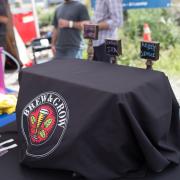Hi,
Pursuant to CHAOS's mission of education and exploration of homebrewing, I'm interested in experimenting with closed system pressurized fermentation, as described in this HomeBrewTalk thread and wiki. A brief summary of the process, as I understand it (never having tried it, of course): beer is brewed as normal and then placed into a pressure-resistant vessel such as a keg or a steel conical fermenter. After aerating the wort and pitching, the fermenter is sealed, and a spunding valve (an adjustable pressure-relief valve) is attached to the gas out port of the keg/fermenter. For the early portion of the fermentation (2-5 days), the pressure-release-point of the spunding valve is kept low, between 0 and 10 psi or so. Once fermentation is mostly complete (around the time you might rack to secondary, if you were into that sort of thing), the spunding valve's release point is ratcheted higher, from 20-30 psi, depending on fermentation temperature and the style of beer. This enables the beer to carbonate as it finishes fermenting. Once the beer has finished fermenting and carbing, and has had a week or so to condition, it is ready to be transferred to a serving keg. This must be done under pressure, since the beer is already carbed. After the beer is transferred to the serving keg and chilled, it should be ready to drink.
The primary advantages to this method, as I understand it, are substantially reduced grain-to-glass times (the HBT thread has instances of lagers going from grain to glass in a month, with quite a bit less time required for ales), as well as reduced potential for oxidation, as the beer is never exposed to oxygen once the fermentation process has started. Plus, no messing around with racking canes to transfer beer, and you get to take gravity/tasting samples with a picnic tap. Among the disadvantages are that the yeast may not attenuate the beer fully if the pressure is raised too early, as higher pressure reduces yeast activity. Additionally, only 4 gallons at a time can safely be fermented in a corny without the risk of krausen blowing off into the spunding valve and messing things up.
After reading a lot of information from the above links, I went and bought the parts to make myself a spunding valve. I intend to try fermenting a ~4 gallon test batch in one of my cornies, after which I will report my results to this thread (and leave the results in the brewhouse keezer). At some point thereafter, I would like to attempt to make a larger batch using a larger fermenting vessel: a sanke 1/2 barrel keg. I know that most or all of the brewhouse sankes are destined to become keggles at some point in the future. If one is available for my experimentation in the next month or so, I would appreciate the opportunity to use it. As far as I am aware, fermenting in a sanke requires no modifications that are not fully reversible, so the sanke I used could be returned to its original purpose after my experiment. I am interested in fermenting in a sanke not merely out of morbid curiosity: a sanke fermenter would provide Chaos with far and away its largest fermentation vessel, capable of fermenting 13-14 gallons in one shot.
So that's my plan. Follow this thread for any updates, or feel free to ask any questions you might have about this method or my experiment.
-Adam










So, my first pressurized fermentation was a definite success. After two days, I turned the pressure relief valve up to about 10 psi, and then after another 4 days I turned it up to 20. Once it got up to 20 for a couple of days, I figured it was almost done, and I took the spunding valve off altogether. After a total of 10 days in the cornie, it was finished fermenting and carbing. I don't know what the final gravity is, since taking a hydrometer reading of a carbonated liquid is unreliable, but I imagine it's pretty much where beersmith says it should be.
I couldn't crash cool the keg, since I don't have a kegerator/keezer. It pretty much sat inside until I decided to let it chill outside for a couple of nights last week. I tasted it, and I think it came out pretty good. If you want to try it, it's in the brewhouse keezer labeled Adam's Fuzzy Yellow Beer. I left a "please don't tap" sticker on it, but if you promise that you are only drinking it out of scientific curiosity, you can feel free to give it a try.
I'll probably try and do this in a cornie a couple more times, and I'm really looking forward to giving it a shot in a sanke.
-Adam
26 or so hours into the fermentation, I couldn't resist taking a hydro sample via the picnic tap. It appears as though it's already about halfway to terminal gravity. This has nothing to do with the pressurized ferment and everything to do with a relatively small beer and a good pitch of healthy yeast, but I'm nevertheless pleased (and a little surprised). Looks like I may be increasing the pressure sooner than I thought.
Just in case anybody is curious, here's what's cooking in the above cornie:
Recipe: FYB Blonde Ale
Style: Blonde Ale
TYPE: All Grain
Recipe Specifications
--------------------------
Boil Size: 5.01 gal
Post Boil Volume: 4.47 gal
Batch Size (fermenter): 4.00 gal
Bottling Volume: 3.91 gal
Estimated OG: 1.046 SG
Estimated Color: 4.4 SRM
Estimated IBU: 25.5 IBUs
Brewhouse Efficiency: 70.00 %
Est Mash Efficiency: 75.3 %
Boil Time: 60 Minutes
Ingredients:
------------
Amt Name
6 lbs Pale Malt (2 Row) US (2.0 SRM)
12.0 oz Munich Malt - 10L (10.0 SRM)
9.0 oz Cara-Pils/Dextrine (2.0 SRM)
0.20 oz Columbus (Tomahawk) [13.50 %] - Boil 60
0.20 oz Columbus (Tomahawk) [13.50 %] - Boil 30
0.20 oz Cascade [4.50 %] - Boil 15.0 min
0.30 oz Cascade [4.50 %] - Boil 1.0 min
1.0 pkg American Ale II (Wyeast Labs #1272)
Evan,
Batch size was just under 4.25 gallons (was shooting for 4), and I pitched my whole .75L starter in there too. So almost 4.5 gallons all told.
Yeah, I went with that pressure release valve so I could just get everything at once from McMaster and pick it up from their will call, thus getting all the parts on the same day and avoiding shipping costs. It's the 30 psi.
-Adam
So my first pressurized fermentation is under way. Had a relatively easy brew day and hit my numbers. I was actually a little bit over, so I put a bit extra into the keg; hopefully it won't blow off into the valve. I put 4 drops of fermcap into the keg in the hopes of preventing excessive krausen.
Here's a picture of it going:
Aerated and pitched the yeast this afternoon, then sealed it up with ~2 psi from my CO2 tank. Just checked and it was sitting at 5 psi. Houston, we have fermentation! I'll check the gravity on Sunday and decide whether to up the pressure at that time.
-Adam
Mark,
One definitely could do this without the adjustable relief valve; in fact, the word "spunding" comes from the german word meaning to close up or seal. Brewers would wait until a beer was almost finished, and then "spund" the barrel, enabling the beer to be carbonated from the last few gravity points. This is easier with lagers, as they ferment more slowly, so catching the beer before it is completely finished is easier. Since I'll primarily be brewing ales (although the idea of room-temperature lager fermentation is intriguing), the spunding valve is simply an easier method to ensure that I get sufficient carbonation.
I'm hoping to brew a 4 gallon batch of a simple blonde ale this week to begin the experiment. I will update as I go.
-Adam
1. This sounds like a great idea worth exploring.
2. While salvaging kegs is a nice stop gap, we need a sanitary welder as a member.....
I bet you could even do this through calculations and skip the relief valve. Just keep an eye on specific gravity.
This sounds awesome. I think doing this in a Sanke keg would be a great way to ferment group brews. Let us know how the test batch works out.
Thats definitely a interisting idea...i know the germans do something like that when they carb their beer ...and you know it must work because they have been making kick ass lager forever. The onlu issue i see is the fermenting vessel. I have heard cornys are not good to ferment in because of there shape (there will be zones the yeast cant reach). But im still interisted in your results.....pls keep us updated